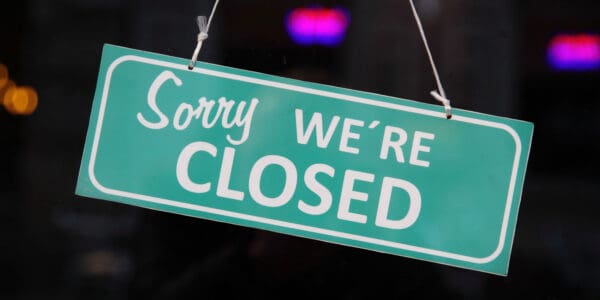Dissolution and liquidation are two ways that a company can be formally wound up and closed. However, these procedures are vastly different from one another and depend on the company’s financial position, assets and liabilities, and trading status.
What is company dissolution?
Company dissolution is the standard way to voluntarily ‘strike off’ a dormant or inactive company from the register at Companies House. This procedure is suitable for companies that have never traded or those which have ceased trading and are now dormant.
You can dissolve a company in this way if it meets the following conditions:
- has not traded or sold off any of its assets or stock in the last three months
- has not changed its name in the last three months
- is not threatened with any insolvency proceedings, e.g. liquidation
- does not have any agreements with creditors, e.g. a Company Voluntary Arrangement (CVA)
- does not have bearer shares in issue
An application to voluntarily strike off a company must be made by the directors (or a majority of them) using Companies House form DS01, which can be completed online (£33 fee) or by post (£44 fee).
Once the application has been processed, Companies House will publish a striking off notice in The Gazette. If no objections are made within two months, the company will then be dissolved and struck off the register. When this happens, the company will no longer exist.
Care must be taken when dissolving a company because there are rules in place to protect shareholders (members), creditors, employees, and anyone else who is likely to be affected by company dissolution. All such parties must be given notice of the company’s intention to strike off before an application is made.
Failure to do so is an offence that can result in significant fines and director disqualification. And if directors fail to notify affected parties with the intention of concealing the strike off application, they can face up to seven years imprisonment.
Please note: you do not have to close your limited company if it is dormant or no longer trading. You can leave it dormant for an indefinite period of time and it will remain registered at Companies House, on condition that you continue to file a confirmation statement and dormant company accounts each year.
What is company liquidation?
Company liquidation is more complex than striking off. This process must be used when a solvent or insolvent company needs to be closed but has outstanding liabilities to pay, including debts with creditors, suppliers, and employees (e.g. wages, redundancy).
A liquidator (licensed insolvency practitioner or official receiver) must be appointed to oversee the liquidation process and deal with the company’s assets and liabilities.
There are three distinct types of liquidation:
- members’ voluntary liquidation – the company is solvent (can pay its bills) but the shareholders want to wind up the business (e.g. to retire)
- creditors’ voluntary liquidation – the company is insolvent (unable to pay its bills) and the directors and shareholders elect to voluntarily liquidate the business in order to pay the company’s debts
- compulsory liquidation – the company is insolvent and is forced into liquidation under a court order
When a company enters liquidation, the appointed liquidator will take control of the business. When this happens, the directors are no longer in charge of the company or any of its assets, and they are not permitted to act for or on behalf of the business.
The role of the liquidator involves:
- interviewing directors and reporting on the reasons for liquidation
- reviewing the company’s assets and liabilities
- dealing with all paperwork and filings
- liaising with creditors and authorities
- disposing of (selling) the company’s assets to pay its creditors
- settling any legal claims and outstanding contracts
- paying liquidation fees and the company’s final tax bills
- getting the company struck off the register at Companies House.
When an insolvent company enters liquidation, directors and staff may be entitled to redundancy and other forms of compensation, depending on the number of hours/week they worked and their length of service with the company. However, redundancy does not apply to solvent companies who enter a members’ voluntary liquidation.
Any proceeds recovered from the liquidation of an insolvent company are split between creditors, in accordance with their hierarchy – the first ‘class’ of creditors being those with fixed charge security on one or more business assets, such as property.
In a solvent company, creditors are repaid in full and any remaining proceeds from the liquidation are distributed to shareholders.
Once the company has been struck off the register at Companies House, any outstanding debts owed by the company will be written off – unless the director(s) provided personal guarantees on any borrowings.
Given the complexity of liquidation and the work that needs to be carried out, it’s not uncommon for this process to take up to a year to finalise.
Please note that the information provided in this article is for general informational purposes only and does not constitute legal, tax, or professional advice. While our aim is that the content is accurate and up to date, it should not be relied upon as a substitute for tailored advice from qualified professionals. We strongly recommend that you seek independent legal and tax advice specific to your circumstances before acting on any information contained in this article. We accept no responsibility or liability for any loss or damage that may result from your reliance on the information provided in this article. Use of the information contained in this article is entirely at your own risk.












Join The Discussion